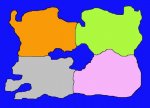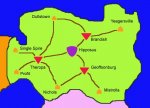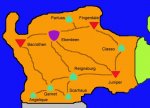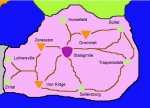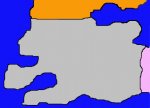Races: Aetoi, Asteres, Boes, Drakontai,
Race: Aetos Plural: Aetoi
Racial Traits:
Abilities: +2 Wisdom, +2 Charisma, -2 Dexterity
Size: Small (+1 to AC, attack; +4 to Hide; uses small weapons and armor)
Speed: 20
Languages: Automatic: Common, Aetoille. Bonus: Auran, Dwarven, Elven, Gnome, Goblin, Halfling
Personable: Aetoi have an innate gift for interpreting other creature’s body language. They receive a +2 racial bonus to Diplomacy, Handle Animal, and Sense Motive checks.
Shield Practiced: The Aetoi love for wearing armor grants them a +1 racial competence bonus to their AC when using a metal shield of any kind except bucklers.
Armor Practiced: The Aetoi spend so much time training in metal armor that they are accustomed to moving in it. All Aetoi are automatically proficient with the chain shirt, scale mail, chain mail, and breastplate. In addition, like dwarves, Aetoi can move their standard movement allowance in medium and heavy armor made of metal. Unlike dwarves, this movement allowance does not pertain to carrying a medium or heavy load unless the Aetoi would be carrying a light load if his armor weight were not included.
Favored Class: Paladin
Physical description:
The Aetoi are a race with all of the typical humanoid characteristics, although their faces are considerably foreign when looked upon by people used to associating with dwarves, elves, and humans. The Aetoi have ears like most other humanoids except that the cartilage on their ears has not separated from the sides of their head. They have narrow eyes, a slim mouth, and their thin noses lay almost completely flat against their faces. In addition, their nose has developed a triangular bony carapace for added protection. Their skin and hair are usually pale and fair.
A typical Aetoi stands about 3’4” tall and weighs about 60 pounds. An Aetos reaches adulthood at 50 years, middle age at 120, old age at 190, venerable age at 260, and the oldest Aetos to ever live was 560 years old. Their short, sturdy bodies are designed to enable them hold a low center of gravity.
They are not as nimble as many of the other small races, but this is often hard to discern because Aetoi outside their homes are almost always in armor. Aetoi can almost always be seen with their shield and single handed weapon at their side.
Relations:
The Aetoi share good relations with any race that presents itself as a fair and law respecting society. The Aetoi are skilled traders and often are responsible for forming large caravans to travel into many different regions – regions often occupied by warring opponents. However, the innate ability for the Aetoi to be diplomatic allows them to gain access to most nations that are respectable in their eyes. Those nations which are evil or have little regard for laws are merely avoided by the Aetoi. They have little desire to impact other cultures that do not share their attitude form goodness and order. However, their penchant for diplomacy does often bring them to the aid of any who legitimately request their help – assuming that the land that requests their help promises to repay any people or lands that they have wronged in the past.
Alignment:
Most Aetoi are Lawful Good. Those few that are not lawful are still almost always good. The Aetoi respect fairness above all else, believing that business and friendship is best accomplished through honesty and trusting relations. Aetoi tend to make friends easily, but they have a tendency to remember those who do not treat their friendship with the same respect that an Aetos does. These people are only forgiven when proper apologies and reparations are made according to what is right in the eye of the one who has been offended. If proper and legitimately honest reparations are made, the Aetoi are honor bound to respect and forgive the prior offenders.
Aetoi Lands:
Aetoi cities are few and far between. Since the Aetoi make friends easily and have a knack for getting themselves accepted into other countries, they have developed into great travelers and a race that is at home in cities with a mixture of other races. Although they are certainly not nomads, an Aetoi caravans can be gone from their home for months or years at a time.
In the few rare places where an entire city of Aetoi lives together, the Aetoi tend to build large and flat cities. Their buildings seldom rise higher than one story and never more than two stories. Because of their constant trade and diplomatic efforts, Aetoi cities often have exquisite goods of very high quality to sell. These goods – and therefore the prices – within these cities are always fair and equitable. The Aetoi cities have a reputation for being able to find nearly anything a person could want as long as you are willing to seek out the right traveler who has journeyed to the proper land.
Religion:
Aetoi worship only the good deity publicly. Aetoi who are not good are so rare that to worship any other deity publicly would bring extreme suspicion and shame upon the Aetos. Those who are not good typically feign a benign respect for the good deity and secretly worship their own deity when they travel.
Aetoi worship is highly structured and typically followed a rigidly prescribed order. Most Aetoi worship across the land occurs at the same time on the same day and involves the same experience for all Aetoi across the land. Sometimes, this is even true across different kindoms, but there are some kingdoms that have different routines because of their different past traditions. In the case where two or more Aetoi meet with differing worship habits, both routines are equally rigid and respected by all Aetoi for the tradition that they are.
Language:
Because Aetoi make excellent traders, Aetoi can speak almost any language with the proper training and reason for learning it. Since Aetoi seldom pursue those who do not accept them, Aetoi do not often have rivals or long-term enemies. Therefore, Aetoi do not often have the need to learn the languages of evil people and their lands. However, any nation that is capable of trade more than likely has an Aetoi who has learned the language to enable trade to ensue. Aetoi frequently learn the language of gnomes, dwarves, and elves since these races often value the bonuses that comes with having Aetoi with whom to trade. Aetoi who leave their home city even once always have taken the time to ensure that they speak common fluently.
Names:
Aetoi names are typically short and full of vowels. Aetoi are named by using their own name first, followed by a prefix attached to their father’s name. If it is a male Aetoi, the prefix is vec; if the Aetoi is female the prefix is vas.
Example male names: Thoo vec-Tao, Fean vec-Grau, Routh vec-Meah
Example female names: Shea vas-Drou, Raenah vas-Nigh, Qua vas-Pahn
Example of a female, her father, and his father: Whue vas-Drau, Drau vec-Gaen, Gaen vec-Bloon
Race: Aster Plural: Asteres
Racial Traits:
Abilities: +2 Intelligence, +2 Wisdom, -2 Constitution
Size: Small (+1 to AC, attack; +4 to Hide; uses small weapons and armor)
Speed: 20
Non-presence: Asteres are innately familiar with magical and psionic means for locating people. They receive a +2 racial bonus on saves against Divination spells or Clairsentience powers. An Aster who casts a Divination spell or manifests a Clairsentient power receives a +1 racial bonus to the DC.
Intellectual Veil: Asteres have a heightened ability to imagine spatial relations and therefore to understand their location from the perspective of others. Thus, they have a better than normal ability to hide and receive a +2 racial bonus on Hide checks.
Clever Perception: Asteres have the ability to mentally retain the common routines of their enemies. Because they learn quickly from previous encounters, Asteres receive a +2 bonus to Spot checks as they are able to better anticipate where to expect to have to look for the prey they are hunting.
Familiar Hunt: Asteres sharpen their tracking and scouting skills on difficult prey. They intentionally hunt animals with the displacement descriptor so that they hone their skills at being able to hide and spot their prey more quickly. Because of this, Asteres gain a +1 racial bonus to attack rolls against any animal with the displacement special ability or an ability that mimics displacement.
Low-light vision: An Aster can see twice as far as a human in starlight, moonlight, torchlight, and similar conditions. In addition, an Aster retains his ability to see in color while using this ability.
Languages: Automatic: Common. Bonus: Dwarven, Giant, Gnome, Goblin, Orc, Terran.
Favored Class: Scout (Complete Adventurer) or Thief (If not using complete books)
Physical description:
Asteres are typically very thin with small framed bodies. Since their race has learned to survive by avoiding conflict altogether rather than dominating other races, most Asteres have bodies that look as though it would not support to much more than an average muscle mass anyway. It is possible for a strong Aster to exist, but it is genetically highly unlikely. An Aster reaches adulthood at 20 years, middle age at 50, old age at 80, venerable age at 110, and the oldest Aster to ever live was 170 years old.
Asteres often have bushy eyebrows which help protect their eyes. Most Asteres do not grow any other facial hair except six whiskers between their noses and their upper lip. These whiskers, three on the left and three on the right, grow long and thin enough to be of little use to the Aster. As a result, most Asteres let their whiskers grow to their maximum length – usually to their lower jaw. A typical Aster has thin features such as eyes, nose, ears, and lips; although many variations on size do occur.
Asteres will wear any particular type of clothing, and they often change to match their surroundings. Because Asteres depend on being able to hide and blend in more than anything else, Asteres seldom wear extravagant and flashy clothing. They will carry jewelry, rings, and other possessions when they are confident they will not draw unnecessary attention or when they can be hidden easily.
Relations:
Asteres have no particular reason to not get along with any other race. Occasional disputes exist between other highly intelligent races, but Asteres dislike direct confrontation enough that even these disputes are not widespread. Some Asteres are not bothered by lower intelligent races, but many Asteres simply do not desire to spent their time with those of lesser intelligence. Often, an Aster will relate to a lesser intelligent creature as an owner might relate to their pet.
Those races that are capable of being on par with the higher intelligence of the Asteres have little to fear from them. Asteres prize trading information as a means of bargaining and establishing relationships, and therefore proving their worth through other means than physical prowess. Most Asteres will willingly bargain to ensure that relationships do not become strained.
Alignment:
Asteres can be of any alignment, although they do bend slightly to the chaotic side. They have all the makings for using their mental abilities in helpful ways as well as harmful ways. But when given a choice, they enjoy being free spirits and using their information in means that suit them.
Asteres Lands:
Asteres mix well in the main cities of the land and therefore do not have cities of their own. You can find Asteres in almost any locale with a tavern or an inn, but the larger the city the more Asteres will usually be present. Larger cities provide more opportunities for the Aster to hone their skills and become greater informants. It is not uncommon to find Asteres in military outposts serving as advance scouts.
Religion:
Asteres typically worship the god of the city in which they dwell. Occassionally an Aster will find a companion that they become so enamored with that they will worship their god out of respect. But when left alone, an Aster will worship whatever the majority of people around them are worshipping.
Language:
Asteres do not have a language of their own; instead they learn the language of the city in which they live. However, Asteres often live around dwarves, gnomes, halflings, and other races of their size. Because of this fact, many Asteres are familiar with the dwarven alphabet and can usually learn to speak any language that follows the same alphabet rules as dwarven.
Names:
Asteres are given names at childbirth, but often they take on descriptors as names in lieu of their real names. Most Asteres met in the world will be known by their descriptor and the city to which they belong. For example, the Wise Sage of Hileos might well be a male Aster living in Helios of a good alignment. Or, the Dark Strategist of Messiteis might be an evil male Aster who once was a scout in the lands around Helios. The Inspector of Lithinoss could well be a female Aster who hires out her services to survey a given area. And the Arrow of Phoneou may just be an evil assassin serving the king of Hamartia.
Race: Bous Plural: Boes
Racial Traits:
Abilities: +2 Constitution, -2 Dexterity
Size: Medium
Speed: 30
Languages: Automatic: Common, Giant. Bonus: Auran, Aquan, Terran, Ignan, Gnome, Goblin, Sylvan.
Mistaken Identity: Boes are often confused with Minotaur by those who do not know the difference. Because of this, many good Bous have been slain by non-Bous in a confused effort to purge the land. This has generated a deep dislike for Minotaur by all Boes. As a result, Boes get a +1 bonus to attack and damage rolls against Minotaur.
Large-handed: Because the Boes possess a size advantage over the typical humanoid, their grip on their weapon makes it easier for them to sunder or disarm. All Boes receive a +1 bonus on attack roll made during the opposed rolls step of an attempt to sunder or disarm an opponent. This bonus also applies if the Boes is subject to a disarm or sunder attempt by an opponent. This bonus does not count in the preceding attack of opportunity if there is one. If the Boes is fighting with a two-handed weapon, the bonus increases to +2.
Solid Body: When making a bull rush, trip, or overrun attack, the Bous receives a +2 bonus to their strength or dexterity check.
Dense Body: Boes bodies are dense in spite of their larger than normal size. A Bous receives a +2 bonus to their Fortitude save to survive massive damage.
Firm Will: Boes are used to having a say in their actions, if not getting their way outright. Because of this, a Bous receives a +2 bonus on any save against an enchantment spell or a telepathic psionic power.
Favored Class: Barbarian
Physical description:
Boes stand between 6’0 and 7’0 tall and weigh between 240 and 350 pounds. Females are slightly larger and heavier than their male counterparts. A Bous reaches adulthood at 20 years, middle age at 40, old age at 60, venerable age at 80, and the oldest Bous to ever live was 120 years old.
Bous have small non-functional horns that begin growing slightly above and forward from their ears. The horns curve backward around the ears, down to the level of their jawbone, and back up to a point just below their eye socket and about one inch away from their skin. Boes horns grow very slowly; by the beginning of adulthood the horns have grown halfway down their skull behind their ears and only at middle age does the horn begin to curl up from the level of the jaw towards the eye. Only a Bous that has managed to make it to a venerable age has horns of a full length. Bous typically live as long as humans.
Bous skin is always dark, often taking on a slight reddish hue over the typical dark brown. During the summer months, the more time a Bous spends outside and in direct sunlight the more the skin takes on a reddish hue – although it never turns more red than brown except through magical means. This effect has no impact upon the abilities of the Bous. Bous eyes are white with either dark green, dark brown, or black irises. Often the colors of the eye are so dark that they make the iris indistinguishable from the pupil. Boes typically have larger than normal hands and long, thick fingers ideal for increasing a tight grip on larger objects.
Bous tend to wear long flowing robes over any other type of clothing, although there is no cultural or social restriction for clothing type. Most clothing worn by Boes is colored in earth tones, but again there is no cultural restriction for coloration. All unmarried Bous wear a ring through one of their nostrils. The ring is silver and through the left nostril for the smaller male Boes; and the ring is gold and through the right nostril for the larger and more dominant female Boes. This ring is typically removed once a Bous has found a mate. Bous are loyal to their mates for life.
Relations:
Because of their great size and unfortunate luck for being mistaken as Minotaur, many Bous live the lives of hermits. It is still uncommon to find a Bous town in more remote areas, but not impossible. Bous typically get along well with other races once they demonstrate that they understand the difference between the Boes and Minotaur kind. Since Boes can be of any alignment, Boes may be found mixing with any race that respects the qualities that a Boes brings to life. Boes may occasionally join together and form large hunting bands in the case where a Minotaur hunter has slain several other Boes. These raiding parties are often feared by the general public, but they are typically of no threat except to the one who is responsible for slaying a Bous because they perceived it as a Minotaur.
Alignment:
Boes have no alignment restrictions. A Bous generally becomes the alignment that prevailed in the society in which they were raised. Boes can be very regimented and raised to respect strict laws; but on the other hand Boes can enjoy the freedom in life that their larger stature tends to bring. Boes can respect the cause of good and helping those around them; but some Boes can be quite capable of understanding greed and domination over others as well. Boes can often learn to appreciate all of the above held in balance.
Boes Lands:
Many Bous do not desire to congregate together in a formal setting. The typical Bous lives a solitary life until mated. In spite of this solitary lifestyle, every Bous belongs to a formal family hierarchy of Boes. Male Boes who mate for life are removed from their own hierarchy and adopted into the hierarchy of their mate. These family hierarchies always meet together in a central location at various times per year. Each family of Boes has their own unique schedule for meeting, but no family of Boes goes without meeting at least four times a year. It is at these meetings that the Boes teach socialization to their children and form parties to take revenge upon Minotaur hunters who may be preying upon family members.
Boes do not claim land for themselves, they exist in the land without care about whose kingdom the land belongs to. Boes usually have a good relationship with the kingdom in which they live, however, because the Boes treat the land as their own and typically care for the land a great deal. Thus, Boes are often welcome in the land once it is discovered that they are not Minotaur. However, even Boes who are welcomed in the land seldom find the urge to become true citizens of a kingdom. Instead, the Boes have their loyalty to family. It is certainly possible for a Boes hierarchy to span across kingdom borders if the Boes family lives near the edge of the border. Most Boes families live within a three days journey of the central family land where they meet.
Religion:
The Boes are most commonly worshippers of nature. They can find many respectable things in religion, so long as the religion is not destructive to their homelands or their people. The Boes have difficulty with extreme fanatics, however, because they are often the victim of mistaken identity and live knowing what types of genocide fanatical thought can lead to.
Language:
Boes are capable of speaking any language, however their opportunities are quite limited as far as which languages they can learn. Most Boes tribes speak a dialect of Giant, which interestingly enough often allows them to converse with any Minotaur they should happen to find and hunt. Boes occasionally have a chance to learn any of the elemental languages of nature: Terran, Aquan, Auran, and most rarely Ignan. Of course, any race which has made itself known to the family hierarchy of Boes of an area has the opportunity to teach them their language as well. Most common in this category are Gnome, Goblin, and Sylvan.
Names:
Boes names are typically guttural sounding. They are given only a single name at birth. Thus, a Boes does not carry a family or surname. At the time in which a Bous sets of on his or her own, usually determined by their parents, the place in which the young Bous chooses to live is adopted by the Bous in the place of a surname. When two Boes mate, the male Bous willingly changes his surname to match the surname of his mate.
Example male names: Groack of the oak grove, Trang of the purple cave, Brist of the tall rock
Example female names: Craash of the narrow river, Ergoth of the apple orchard, Herthosh the cliff dweller
Race: Drakontos Plural: Drakontai
Racial Traits:
Abilities: +2 Charisma, +2 Wisdom, -2 Dexterity
Size: Medium
Speed: 30
Feat: Draconic Heritage (Complete Arcane) at 1st level regardles of initial class taken
Skill Points: 4 extra skill points at 1st level, 1 extra skill point per level thereafter
Languages: Automatic: Common, Draconic. Bonus: Auran, Elven, Giant, Sylvan, Terran
Lowlight Vision: Drakontai are blessed with good eyesight, and have lowlight vision as elves do.
Favored Class: Sorcerer
Physical description:
Drakontai appear as normal humans, their draconic heritage is buried deep in their otherwise human genetic make-up. Most live in and among humans and it is quite possible that a drakontos is not aware of his special heritage. In this case, however, the drakontos still benefits from his Draconic Heritage, it is merely viewed as special knack for a particular type of task. A typical male drakontos stands just over 6' tall and weighs about 200 lbs. The typical female stands about 5'10" and weighs 160 lbs. However, the range of drakontai heights is between 5'4" to 6'8" and ranging between 110 lbs and 275 lbs. A Drakontos reaches adulthood at 75 years, middle age at 175, old age at 275, venerable age at 375, and the oldest Drakontos to ever live was 775 years old. This extended life span can cause problems from Drakontai who are unaware of their heritage and who live among normal humans.
The hair of a Drakontos often takes on highlights of their Heritage, but the base color remains a typical shade for a human. In addition to the hair, a Drakontos has a 90% chance that one eye is the same color as their Heritage Dragon and a 60% chance that both eyes are the same color of their Heritage. This means that it is possible for a fair number of Drakontai to have different colored eyes and to experience eye color change over the course of their lives. Any Drakontos whose eye or eyes match their Heritage Dragon also experiences the same color change as the Heritage Dragon. The change is very slow and gradual, however, because the Drakontai are blessed with long lives. This physical effect with the eyes may also make it difficult for a Drakontos who is unaware of his heritage and living among normal human beings.
Relations:
Those who are not aware of their heritage mix freely with humans and all the races who accept humans in their midst. Drakontai who are aware of their heritage also freely mix with all races, but they gravitate towards elven communities. Drakontai have a deep respect for all who claim power from the land or the sky. In general, Drakontai tend to value timely sage advice and strength of character among those they interact with.
Alignment:
Drakontai can be of any alignment, but they are seldom ever truly neutral in regard to both axis. The Drakontai personality is genetically tied to their heritage, and thus each Drakontos must be within one step of the alignment for their Heritage Dragon on one axis and the other axis must match exactly. Thus, a Drakontos of Silver Dragon Heritage may only be Lawful Good, Lawful Neutral, or Neutral Good. The Heritage is so strongly woven to the Drakontos' personality that they will never act out of their own alignment unless they are under the influence of a magical effect.
Drakontai Lands:
While many Drakontai live among humans and may even be completely unaware of their Heritage, there are Drakontai areas and communities that do exist. These communities are always served, protected, or controlled by a dragon (or dragon family) of their Heritage. The good aligned Drakontai are protected and looked after by their Heritage dragon, while evil Drakontai are often slave cultures existing purely for the amusement, military might, or even appetite of their Heritage dragon. Because dragons tend to be solitary animals, Drakontai communities also tend to be found in very remote locations, well off the beaten path.
Religion:
Like humans, Drakontai worship the entire range of deities. However, any Drakontos who lives in a town that is protected or controlled by their Heritage Dragon will honor the dragon’s deity as well as their own deity.
Language:
Drakontai have an innate knack for learning and understanding Draconic, even those who are unaware of their heritage. Because of the love that the Drakontai have for the earth, the air, and all things that draw power out of these sources a Drakontai often can speak Auran, Elven, Giant, Sylvan, or Terran.
Names:
Drakontai adopt a wide variety of names. Their names can match any name that is commonly found in human lands. Many Dracontai are given elven names out of respect for that culture which lives as long as they do and respects the earth as much as Drakontai do.

